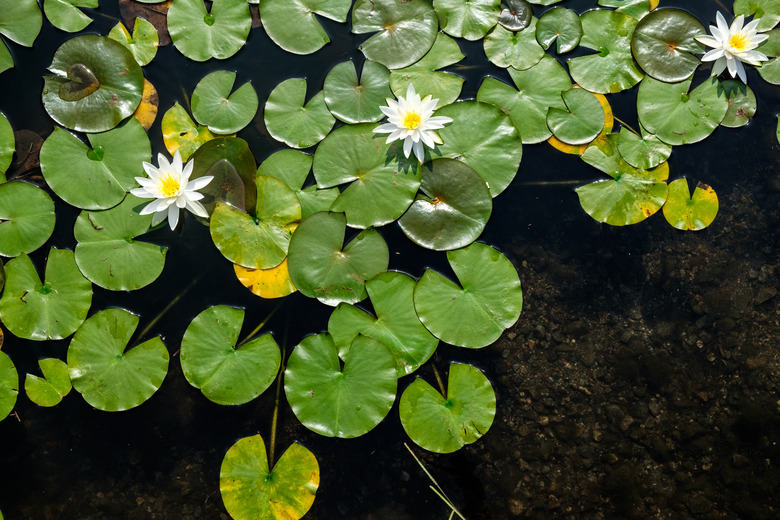Aquatic Plants With Special Adaptive Features
Aquatic plants have adapted in a number of special ways in order to cope with their environments. There are many kinds of aquatic plants, each with distinct adaptive characteristics; these plants may be either entirely floating, submerged or partially submerged, as in the case of many swamp and wetland plant species.
Water Lily
Water Lily
The water lily is an example of a floating plant. Floating plants grow on the surface of the water and are anchored by their roots to bottom of the body of water. Water lilies have adapted so that chloroplasts are present only on the surface of the leaves that are exposed to the sun. Chloroplasts contain the pigments that absorb sunlight for photosynthesis, a reaction that plants need to create energy. As the other side of the leaf is permanently submerged, no chloroplasts are needed. Another important adaptation of water lilies is the lateral spreading of their leaf canopy. While trees on land grow upward as their leaves compete for sunlight, water lily leaves expand across the water´s surface for optimal exposure, as tall aquatic plants do not typically dominate their waters. Water lilies depend upon the surface tension of the water to anchor their leaves, making them prominent in freshwater pond and lake situations, where water is typically still and calm.
Hornwort
Hornwort
The hornwort is a type of aquatic plant that remains completely submerged in the water. Submerged plants may or may not have a root system, as the role of the root system is reduced merely to that of an anchor in the underwater soil. Hornworts do have roots, but they have adapted to spread nutrients throughout the plant body without them. In addition, structures such as the xylem and phloem, which are responsible for water retention, nutrient distribution and structural support are absent in hornworts, for all of this is achieved by the suspension and movement of water and nutrients throughout their aquatic environment. While most plants require heavy structural material for growth and strength, the body of the hornwort is minimal in this regard, for its light and limp composition provides less resistance to the surrounding water, and thus more resistance to possible damage.
Cattail
Cattail
The cattail is an example of a partially submerged plant. They may be found in swamps, bogs and wetlands with either permanent or seasonal submergence in water. Cattails have waxy leaves that protect them from the water, as well as chloroplasts on both sides to take advantage of the sun when they are emerged. Cattails have adapted a thin, chute-like figure in order to provide minimal resistance to high winds and the water´s surface, swaying to the side rather than ripping or tearing. They also tend to be tall, in order to guarantee some portion of emergence for sunlight absorption. Cattails have adapted very efficiently with regards to reproduction. Beneath the water´s surface, the plant spreads by structures called rhizomes, while the brown flower located at the top of the plant is densely packed with seeds. The wind and the water´s current spread these seeds with ease, allowing cattails to reproduce rapidly.
References
Cite This Article
MLA
Higgins, Justin. "Aquatic Plants With Special Adaptive Features" sciencing.com, https://www.sciencing.com/aquatic-plants-special-adaptive-features-6748354/. 13 March 2018.
APA
Higgins, Justin. (2018, March 13). Aquatic Plants With Special Adaptive Features. sciencing.com. Retrieved from https://www.sciencing.com/aquatic-plants-special-adaptive-features-6748354/
Chicago
Higgins, Justin. Aquatic Plants With Special Adaptive Features last modified March 24, 2022. https://www.sciencing.com/aquatic-plants-special-adaptive-features-6748354/
